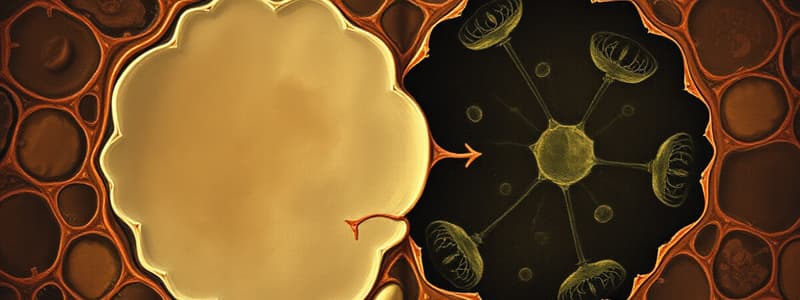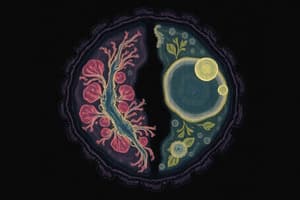Podcast
Questions and Answers
What does MPF trigger?
What does MPF trigger?
It triggers the cell's passage past the G2 checkpoint into the M phase.
What happens if all the chromosome kinetochores are not attached to spindle fibers?
What happens if all the chromosome kinetochores are not attached to spindle fibers?
The sister chromatids remain together, delaying anaphase, and the M phase checkpoint is not passed.
What is a growth factor?
What is a growth factor?
A protein released by cells that stimulates other cells to divide.
What is platelet-derived growth factor (PDGF)?
What is platelet-derived growth factor (PDGF)?
Signup and view all the answers
How does PDGF stimulate fibroblast division?
How does PDGF stimulate fibroblast division?
Signup and view all the answers
What is density-dependent inhibition?
What is density-dependent inhibition?
Signup and view all the answers
What is anchorage dependence?
What is anchorage dependence?
Signup and view all the answers
What is the source of the HeLa cell?
What is the source of the HeLa cell?
Signup and view all the answers
What is transformation in cell biology?
What is transformation in cell biology?
Signup and view all the answers
What is metastasis?
What is metastasis?
Signup and view all the answers
What is a benign tumor?
What is a benign tumor?
Signup and view all the answers
What is a malignant tumor?
What is a malignant tumor?
Signup and view all the answers
What is radiation in cancer treatment?
What is radiation in cancer treatment?
Signup and view all the answers
What is chemotherapy?
What is chemotherapy?
Signup and view all the answers
What are proto-oncogenes?
What are proto-oncogenes?
Signup and view all the answers
What are tumor suppressor genes?
What are tumor suppressor genes?
Signup and view all the answers
What do out of control cancer cells do?
What do out of control cancer cells do?
Signup and view all the answers
What is cell division?
What is cell division?
Signup and view all the answers
What is the cell cycle?
What is the cell cycle?
Signup and view all the answers
What are three key roles of cell division?
What are three key roles of cell division?
Signup and view all the answers
What is a genome?
What is a genome?
Signup and view all the answers
What are chromosomes?
What are chromosomes?
Signup and view all the answers
What is chromatin?
What is chromatin?
Signup and view all the answers
What are somatic cells?
What are somatic cells?
Signup and view all the answers
What are gametes?
What are gametes?
Signup and view all the answers
How many chromosomes are in a human somatic cell?
How many chromosomes are in a human somatic cell?
Signup and view all the answers
What are the two types of gametes?
What are the two types of gametes?
Signup and view all the answers
How many chromosomes are in a human gamete?
How many chromosomes are in a human gamete?
Signup and view all the answers
How many DNA molecules are in each of your somatic cells?
How many DNA molecules are in each of your somatic cells?
Signup and view all the answers
What are sister chromatids?
What are sister chromatids?
Signup and view all the answers
What are cohesins?
What are cohesins?
Signup and view all the answers
What is a centromere?
What is a centromere?
Signup and view all the answers
What is mitosis?
What is mitosis?
Signup and view all the answers
What is cytokinesis?
What is cytokinesis?
Signup and view all the answers
Where does meiosis occur?
Where does meiosis occur?
Signup and view all the answers
What process replaces damaged cells in a wound?
What process replaces damaged cells in a wound?
Signup and view all the answers
What process forms eggs?
What process forms eggs?
Signup and view all the answers
Which process produces identical daughter cells?
Which process produces identical daughter cells?
Signup and view all the answers
Which process reduces the chromosome number of daughter cells?
Which process reduces the chromosome number of daughter cells?
Signup and view all the answers
What is the mitotic (M) phase?
What is the mitotic (M) phase?
Signup and view all the answers
What is interphase?
What is interphase?
Signup and view all the answers
What happens during the G1 phase?
What happens during the G1 phase?
Signup and view all the answers
What is the S phase?
What is the S phase?
Signup and view all the answers
What is the G2 phase?
What is the G2 phase?
Signup and view all the answers
What is a mitotic spindle?
What is a mitotic spindle?
Signup and view all the answers
What is a centrosome?
What is a centrosome?
Signup and view all the answers
What is an aster?
What is an aster?
Signup and view all the answers
What are the components of the mitotic spindle?
What are the components of the mitotic spindle?
Signup and view all the answers
What is another name for the centrosome?
What is another name for the centrosome?
Signup and view all the answers
What happens to the centrosome during interphase and prophase?
What happens to the centrosome during interphase and prophase?
Signup and view all the answers
What is a kinetochore?
What is a kinetochore?
Signup and view all the answers
What happens in the G2 phase and how is it controlled?
What happens in the G2 phase and how is it controlled?
Signup and view all the answers
What happens in the M phase and how is it controlled?
What happens in the M phase and how is it controlled?
Signup and view all the answers
What is the G0 phase?
What is the G0 phase?
Signup and view all the answers
What is a protein kinase?
What is a protein kinase?
Signup and view all the answers
What activates cyclin-dependent kinases?
What activates cyclin-dependent kinases?
Signup and view all the answers
What is cyclin?
What is cyclin?
Signup and view all the answers
What are cyclin-dependent kinases (Cdks)?
What are cyclin-dependent kinases (Cdks)?
Signup and view all the answers
What is MPF?
What is MPF?
Signup and view all the answers
Why does the activity of cyclin-dependent kinases rise and fall?
Why does the activity of cyclin-dependent kinases rise and fall?
Signup and view all the answers
Study Notes
Cell Division and Cycle
- Cell division is essential for the reproduction of cells.
- The cell cycle comprises an ordered sequence of events, including interphase (G1, S, G2) and M phase (mitosis and cytokinesis).
- Key roles of cell division: reproduction, growth and development, and tissue renewal/repair.
Genomic Structures
- The genome includes the complete DNA endowment of a cell, encompassing all genes and noncoding sequences.
- Chromosomes are cellular structures that carry genetic material, each made of a long DNA molecule and proteins.
- Chromatin is the DNA-protein complex that maintains a dispersed form when the cell is not dividing.
Somatic and Gametic Cells
- Somatic cells are any body cells, excluding sperm and egg cells.
- Gametes (sperm and eggs) are haploid reproductive cells that unite during fertilization to form a diploid zygote.
- A human somatic cell contains 46 chromosomes, while a human gamete contains 23 chromosomes.
Chromatin and Chromosome Dynamics
- Sister chromatids are identical copies of a duplicated chromosome held together at the centromere.
- Cohesins are protein complexes that maintain sister chromatid attachment.
- The centromere region is critical for chromatid cohesion and chromosome movement during division.
Mitosis and Cytokinesis
- Mitosis occurs in five stages: prophase, prometaphase, metaphase, anaphase, and telophase, ensuring equal chromosome distribution.
- Cytokinesis is the cytoplasmic division that follows mitosis, completing cell division.
- In animal cells, cytokinesis involves a cleavage furrow; in plant cells, it forms a cell plate.
Specialized Cell Structures and Functions
- The mitotic spindle, formed from microtubules, organizes chromosome movement during mitosis.
- Centrosomes serve as microtubule-organizing centers and play a pivotal role in spindle formation.
- Kinetochores are protein structures attached to centromeres linking sister chromatids to the spindle apparatus.
Checkpoints and Cell Cycle Control
- The cell cycle is regulated by control systems, ensuring proper progression at checkpoints (G1, G2, M).
- G1 checkpoint determines if the cell proceeds based on growth signals and DNA integrity.
- G2 checkpoint assesses DNA replication completion, while the M checkpoint ensures proper chromosome alignment.
Regulatory Molecules
- Cyclins and cyclin-dependent kinases (Cdks) are critical for cell cycle regulation.
- MPF (maturation-promoting factor) is essential for transitioning from G2 to M phase.
- Changes in cyclin concentration influence the activity of Cdks, impacting the cell cycle progression.
Growth Factors and Cell Interaction
- Growth factors stimulate cell division and are critical for repair and tissue growth.
- Density-dependent inhibition prevents cells from dividing when in contact with each other.
- Anchorage dependence requires cells to attach to a substrate to initiate division.
Binary Fission and Prokaryotic Reproduction
- Binary fission is the prokaryotic reproductive method that results in two identical cells.
- Prokaryotic chromosomes are circular, contrasting with the linear chromosomes found in eukaryotes.### Hela Cells
- Originated from Henrietta Lacks in 1951, derived from her cervical cancer caused by HPV.
Transformation
- Refers to the conversion of a normal animal cell into a cancerous cell.
Metastasis
- Involves the spread of cancer cells to distant locations away from their original site, complicating treatment.
Benign Tumor
- Consists of abnormal cells that exhibit specific genetic and cellular changes.
- These cells typically cannot survive at new sites and remain localized at the tumor's site of origin.
Malignant Tumor
- Characterized by cancerous cells with significant genetic and cellular alterations.
- Capable of invading nearby tissues and can metastasize, impairing the functions of one or more organs.
Radiation
- A treatment method that damages the DNA of localized cancer cells to inhibit their growth and replication.
Chemotherapy
- Involves the use of toxic drugs administered throughout the circulatory system targeting actively dividing cancer cells.
Proto-oncogenes
- Normal genes found in cells that stimulate cell division; usually kept off.
- Mutations can activate these genes continuously, transforming them into oncogenes associated with cancer.
Tumor Suppressor Genes
- Encode proteins that inhibit cell division in normal cells, maintaining control over the cell cycle.
- In cancer cells, these genes are turned off, leading to unregulated cell division.
Characteristics of Out-of-Control Cancer Cells
- Form tumors that disrupt normal tissue structure and function.
- Lose adhesion to other cells, allowing them to break away and proliferate throughout the body (metastasis).
- Possess the ability to live indefinitely until the organism's death, contributing to the progression of cancer.
Studying That Suits You
Use AI to generate personalized quizzes and flashcards to suit your learning preferences.
Description
Test your knowledge of key concepts from Chapter 12 of AP Biology with these flashcards. Focus on essential terms such as cell division and the cell cycle, including interphase and mitosis. Perfect for reviewing critical biological processes.




